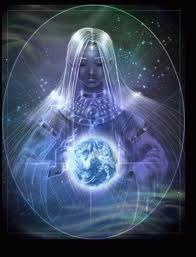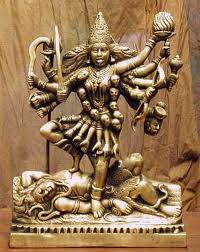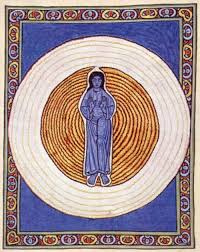
(Concluded from Part 1.)
The vision I had on Feb. 13, 1987 showed me the purpose of life and the relationship that prevailed among the Trinity of Divine Beings. I’d never have arrived at that knowledge without its help.
Let me summarize what I learned.
It showed me that God is all there is – omnipresent, omnipotent, omniscient, etc.
If there were no physical reality – which takes in all twelve dimensions – no differentiation into individual beings, no appearance of another to the One, then we’d just speak of “God” and there’d be no Trinity.
But, apparently, the formless, all-present God wanted to know itself, not an easy task when one is all there is, filling every nook and cranny of existence. You can’t step back from the camera and have your picture taken when you fill up the whole universe and beyond.
So God resolved to create a leela or divine play to accomplish that task. He decided to create the world, us, laws that govern both, a material dimension in which fragments of itself could grow and learn their true identity, resulting in enlightenment.
Twentieth Century Christian mystic Beinsa Douno explains why: “Why did God desire to create the world? So that He might be made manifest.” (1)
And why did God desire to be made manifest? Says Sufi Sage Ibn Arabi: “I was a hidden treasure and I loved to be known, and I created the creation so that I be known.” (2)
And why does God want to be known? Explains Paramahansa Ramakrishna: “The Godhead … has become these two [God and the devotee] in order to enjoy Its own bliss.” (3)
All the time, it’s only God who plays all roles. Said Franklin Merrell-Woolf: “This space I produce that My Glory shall be revealed yet I alone Realize that Revelation.” (4)
To achieve its plan to become known and enjoy its own bliss, God began by dividing itself in two – which ancients came to call, probably paternalistically, the Father and the Mother.

The active Mother (Shakti) stands on the inactive Father (Shiva)
The Father is the Transcendental Void, silent and motionless, empty of all things material, the Source of everything that is and is not. (5) The Mother is the breath of God (spiritus sancti), the primal force, the universal creative vibration called Aum, Creator, Preserver, and Transformer of all individuated beings and material environments (universes).
Hindus illustrate this by representing Shakti as dancing on the recumbent body of Shiva. She is active; he is inactive.
The Mother is the active face of the One and the Father is the passive face.
Because the Mother speaks and acts, she’s the only one of the two (Father and Mother) that we can see and talk to.
She leads us to the Father, as Swami Sivananda told us earlier.
To leave the dream world we inhabit, we have to do three things: (A) Know and realize ourselves, what Jesus called the Christ and what Hindus call the Atman, and (B) Know and realize the Mother, the Dream Weaver of this realm of divine illusion, of instructive smoke and mirrors designed to show us who we are; and (C) Know and realize the Father, the transcendental, love-filled void from which all material things arise.
 The relationships that prevail among the Trinity, as seen from the standpoint of the individual, are illustrated in Hildegard of Bingen’s vision, left.
The relationships that prevail among the Trinity, as seen from the standpoint of the individual, are illustrated in Hildegard of Bingen’s vision, left.
In that depiction, the Son/Christ, is inside the Mother’s creation (brown, ringed area), but connected to the Father (grey, ringed area), which, as the conditioned or personal God, is shown located within the unconditioned God or Godhead (purple). That for me is an accurate representation of the relationship that prevails among the figures of the Trinity.
The one thing represented in Hidegard’s vision that I neglected to take note of in mine was the Godhead, denoted by the purple in her depiction and denoted by the black sky, the background for everything that was happening, in my vision. I simply took it for granted.
Let me offer an example of a sage realizing the Mother. Ramakrishna’s guru, Totapuri, only accepted the existence of the formless Transcendental God (or Brahman). However, one day, the Divine Mother announced herself to him and altered his life.
“Suddenly, in one dazzling moment, [Totapuri, saw] on all sides the presence of the Divine Mother. She is in everything; She is everything. She is in the water; She is on land. She is the body; She is the mind. She is pain; She is comfort. She is is life; She is death. She is everything that one sees, hears, or imagines. She turns ‘yea’ into ‘nay,’ and ‘nay’ into ‘yea.’
“Without Her grace no embodied being can go beyond Her realm. Man has no free will. He is not even free to die. Yet, again, beyond the body and mind She resides in Her Transcendental, Absolute aspect. She is the Brahman [Father, God] that Totapuri had been worshipping all his life.” (6)
When we know the Mother, we’ve achieved cosmic consciousness or what Hindus call savikalpa samadhi, trance state with form remaining.
The next step for us is to have transcendental consciousness or what Hindus call Brahmajnana (God-Realization) or nirvikalpa samadhi, trance state in which form yields to formlessness and realization of the Father. Then we’ve had our first taste of transcendental knowledge. It will not be our last.
Each time an individual mounts another step of enlightenment in the stairway to reunion with the Divine, God meets God. For that purpose was all of life created.
Because the Father is silent and still and only the Mother speaks and moves, you’ll be hearing the archangels, ascended masters, and galactics say that they “report” to the Mother, serve her, carry out her Plan, etc.
The Mother is known to all religions. Why do all seek to know her? As Totapuri showed us and King Solomon testifies: “She is more precious than rubies; and all things thou canst desire are not to be compared with her.” (7)
Swami Nikhilananda sums up all we know about her:
“She projects the world and again withdraws it. She spins it as the spider spins its web. She is the Mother of the Universe, identical with the Brahman of Vedanta, and with the Atman of Yoga. As eternal Lawgiver, She makes and unmakes laws; it is by Her imperious will that karma yields its fruit. She ensnares men with illusion and again releases them from bondage with a look of Her benign eyes. She is the Supreme Mistress of the cosmic play, and all objects, animate and inanimate, dance by Her will. Even those who realize the Absolute in nirvikalpa samadhi are under Her jurisdiction as long as they live on the relative plane.” (8)
This article is intended as a contribution to a cross-cultural spirituality, which itself is a contribution to building Nova Earth.
Footnotes
(1) Beinsa Douno, “Life is the Musical Manifestation of God,” The Wellspring of Good. Downloaded from https://www.beinsadouno.org/lib/sg.htm, accessed 21 Feb. 2005. , n.p.
(2) Muhyideen Ibn Arabi, Kernel of the Kernel. trans. Ismail Hakki Bursevi. Sherborne: Beshara, n.d., 3.
(3) Swami Chetananda, They Lived with God. Life Stories of Some Devotees of Sri Ramakrishna. St. Louis: Vedanta Society of St. Louis, 1989, 126.
(4) Franklin Merrell-Wolff, Pathways Through to Space. A Personal Record of Transformation in Consciousness. New York: Julian Press, 1973, 18.
(5) The term “Father” is often used to refer to both the conditioned and the unconditioned God, God with form and the formless Godhead, the personal and impersonal God, Siva and Mahasiva. The Divine Masculine is associated with stillness and silence.
(6) Notice the implication by an avatar (Sri Ramakrishna) that even at the highest levels of reality, bliss continues to be sought after. That persuades me again that we don’t transcend these states but go deeper and deeper into them.
(7) “It behooves … the aspirant [to] approach the Mother first, so that She may introduce Her spiritual child to the Father for its illumination or Self-realization.” (Swami Sivananda in Swami Sivananda Radha, Kundalini Yoga for the West. Spokane: Timeless Books, 1978, 25.)
(8) Swami Nikhilananda, trans., The Gospel of Sri Ramakrishna. New York: Ramakrishna-Vivekananda Center, 1978; c1942, 31. [Hereafter GSR.]
(9) Proverbs 3:13 and 15.
(10) GSR, 30.

